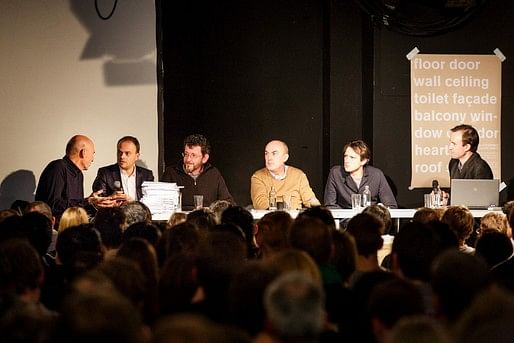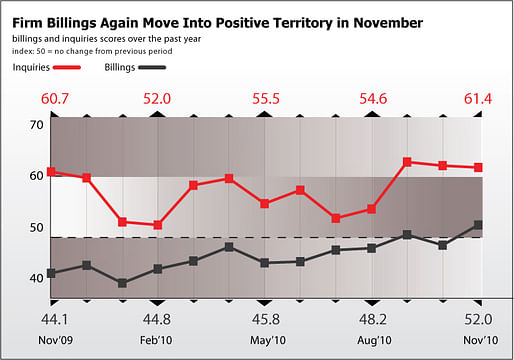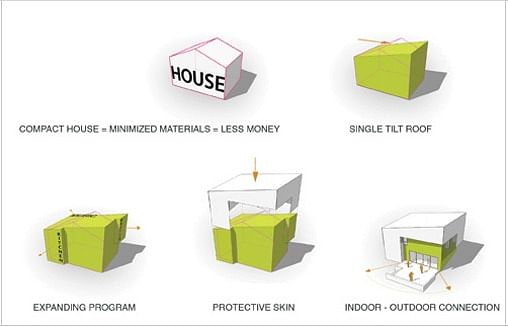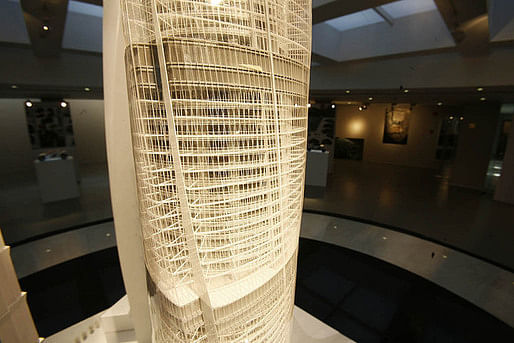
In the latest edition of the Showcase series, Archinect highlighted House in Moreira, by Phyd Arquitectura. The house has "Patios that enable continuity between different spaces of the house and interior/exterior which behave like a sun clock, alternating solid and diffuse light". Thayer-D questioned "What's with conceptual purity at the expense of function and maybe joy?" but Vile Child chimed in "seems SupraJoyful to me"

With the latest edition of the Showcase series, Archinect highlighted House in Moreira, by Phyd Arquitectura. The house has "Patios that enable continuity between different spaces of the house and interior/exterior which behave like a sun clock, alternating solid and diffuse light".

Thayer-D questioned "What's with conceptual purity at the expense of function and maybe joy?" but Vile Child chimed in "seems SupraJoyful to me. But I like form and space and mass and light and how the colors outside reflect on the white walls. Shit like that".

Plus, Jaakko van ‘t Spijker reported in from the first findings of a studio in the Harvard GSD program, dealing with ‘the Elements of Architecture’. Which were publicly presented in a packed Dependance at the Schieblock in Rotterdam on Friday night, November 16th. The feature led glass to comment "I find OMA creates some of today's most compelling architecture using standard off-the-shelf parts in unique and exhilarating ways.... Do we need to supplement mass production with mass customization to create tomorrows architecture? I feel OMA has been proving otherwise”.
News
According to the latest data from Kermit Baker, AIA Chief Economist, revenue at U.S. architecture firms increased in November and 52.0, the AIA’s Architecture Billings Index (ABI) recorded a three point gain from the previous month, and reached its strongest level since December 2007. Yet, Mr. Baker cautioned it is still slow going with an uncertain year ahead.

Heart of the Metropolis, the international architectural competition for the design of the Helsinki Central Library announced six proposals to move on to the competition's second stage. The final winner will be announced in June 2013. Steven Ward believed "the proposals here seem less arbitrary / more specific than a lot of the competition results i've been seeing lately...no computer gyrations and technical bravado, except in support of the intended proposal". HandsumCa$hMoneyYo though, thought "some of those large open plazas look like they'd be pretty miserable to walk across during the long Finnish winter".

Last week UCLA A.UD launched IDEAS, a new platform for cross-disciplinary research collaborations among students, faculty, industry and other partners. The revamped, self-supported Master of Architecture II program, which will continue to be known as SUPRASTUDIO, but has been expanded threefold, from 15 to 45 students, for the 2013–14 academic year. During these yearlong, post-professional studios, students will study with one of the three world-renowned, award-winning architects, focusing on a research theme in collaboration with an industry or nonprofit partner and a broad array of outside consultants. jamesarch was "Disappointed in UCLA on this one”. In his opinion “ All three choices are questionable. Should be called ‘whose the bigger name’ studio."
Oliver Wainwright pointed out that Russia's Mercury City tower has overtaken the Shard to become the tallest building in Europe. Nector, Eric Chavkin offered the following critique "The forward-leaning angles recall Soviet constructivist monuments like Taltin's to the Third International. The overall progressive rthymn is right out of Ladovsky's beginning course on basic architectural design. Full circle. Who said that History repeats itself" while 18x32 wondered "What's with the Guardian and being unable to write any kind of revew beyond ‘phallic’? It's easily the least interesting or relevant angle of critique.”.
Over at PopSci, Colin Lecher with the help of a few forward-thinking professionals in the business of buildings, offered a Reimagining Buildings Of The Past With The Materials Of The Future. metal was intrigued "carbon nanotubes could be used to make materials stronger and lighter, but who would have thought of mixing them into concrete"...
Firms/Blogs/Work Updates
Tonic Design + Tonic Constructi received a Merit Award from the North Carolina Chapter of the American Institute of Architects (AIA NC) for its design and construction of the 'Crabhill Modern' house in Hillsborough, NC.


Ibrahim Rajah recently worked on new tower components and AwesomeArchitecture highlighted Melkwegbridge in Purmerend, Netherlands a work by NEXT Architects. mantaray asked for some clarification "'This deck was designed as a pendulum over the water, so that the slope could be limited to a minimum.’ I'm not sure I understand what you mean by this. Can you clarify? Also, what kind of water traffic uses the river (canal?) here?".

everydayintern started a blog, the Architectural Ellipsis dedicated to those aspects of the profession we (perhaps intentionally) omit, gloss over, or let dwindle in silence primarily those that occur in the internship process.
In the first post everydayintern wrote "According to NCARB, IDP takes roughly as long as it takes to get your degree but compare the wealth of information out there about narrowing down, applying to and surviving architecture school to the single-sided propaganda of NCARB about the internship process. I'm fairly certain that the architecture community as a whole would rather talk about the glory days as a student staying up nights in studio than braving paper cuts to finish scanning a set of as-builts as an intern".
Schools/Blogs
As part of University of Kentucky-College of Design’s River Cities Project, professors Filson and Rohrbacher led the Atomic Cities Research Group in an investigation of prosperous, post-nuclear futures for the Paducah Gaseous Diffusion Plant (PGDP). The research team developed interactive models that enable citizens, policymakers, contractors and scientists to visualize, understand and discuss the site's underground contamination and to test, plan and design future scenarios for the plant.

pwang/DexLab started a blog affiliated with The College of Architecture and Design at Lawrence Tech and begins by explaining "'Re Activate’ Blog is a container which can hold various events\designs simultaneously. So my goal is to create the framework to plug in cells to re activate this urban device". The first few posts feature work from the China Workshop Series - Summer 2009- 2012.
Elena Papademas documented final reviews for the first studio assignment at EPMA at Tsinghua University. Landscape Urbanism was the focus and Eva Castro, Nicola Saladino, Libny Pacheco and Federico Ruberto were the main tutors.
Discussions
jla-x started a thread to discuss whether it is time to start an interns union? wurdan freo felt "Drafting in the trades is considered a labor position...thus can be signatory to the laborers union...So there is a precedent. I think it's a joke however and would gladly ship my production drafting to Mexico" but curtkram thought it a good idea because "a unionized labor force for young architects or aspiring architects would not be amenable to the high turn-over these firms have come to depend on".
To threadkilla however, "If interns unions were to have the responsibility of providing professional development opportunities to unlicensed architects, ensuring that their members are the most qualified for the practice of architecture, I don't see how this would be a terrible idea. So for those of you who think that a unionized plumber is preferable to a non-union contractor, because membership in the union guarantees a level of expertise - wouldn't this do the same thing for entry-level architects if the unions only admitted qualified people, and then provided a structure for continued learning?"
hyperfunkulus is a licensed architect who has a technical question regarding - High Water in the basement/pit of a rcently completed lube center. ..
The problem; "The floor and walls of the pit are all CIP concrete. The pit is dry, water-proofed inside and out, has gravel around the walls and under the slab, filter barriers and a continuous french drain around the perimeter with a separate, detached sump pit that houses two pumps (primary and back up). Grade around the building is mostly paved and sloped away from the building. Since the project's completion about a year ago, the pumps have run continuously, pulling water from around the pit and dumping it into a retention pond which is at a lower elevation and about 100'-0" away".
won and don williams posted "usernametaken's questions are more helpful than mine, but did you have a civil engineer on the project? Seems like the water table issues should have been discovered in design/engineering or at latest during construction". Somewhat helpfully snook_dude noted "Sounds like you might have wanted to use geo tex benonite waterproofing in the pit. I have used it and it is a pain, and expensive. It does however keep water from coming into the building...I think this application is not realistic at this time but for future reference".
w. architect asked Facing Israeli aggression, how can architects throughout the world help the Gaza strip people? aphorismal replied "Call me a cynic, but you can't. You're an ARCHITECT, not a conflict negotiator. I love when architects assume that any situation with people in crisis is only missing one key ingredient...Sprinkle some architecture on that shit and it'll fix itself!"
Kamil Muhammad recommended "everyone should read Lethal Theory by Eyal Weizman to learn how IDF operates and how it relates to architecture/urbanism. Very powerful reading" and Orhan Ayyüce had an idea "how about israel ending its blockade to gaza, recognize the elected entity of hamas, return what the settlers took in gaza, west bank and elsewhere or accept one state solution with equal rights to palestinians? i bet these would reduce the violence to insignificant levels" "
Finally tammuz quipped "Orhan, you sound(ed) like a reasonable person but really you have proven to be another ignorant middle eastener (eheheheh)".
Additionally
Adam Greenfield has been out Occupying Sandy and contemplating interaction design, to whit; "Occupy Sandy’s effectiveness constitutes both powerfully impressive testimony as to what ordinary people can achieve when organized in a horizontal, leaderless, distributed and consciously egalitarian network, and a rebuke to the seeming inability of the centralized, hierarchical and bureaucratic organizations to which our society has hitherto entrusted mission-critical disaster recovery functions to cope with what this responsibility demands of them". via bruces
No Comments
Block this user
Are you sure you want to block this user and hide all related comments throughout the site?
Archinect
This is your first comment on Archinect. Your comment will be visible once approved.